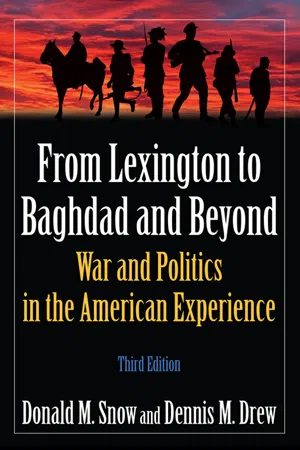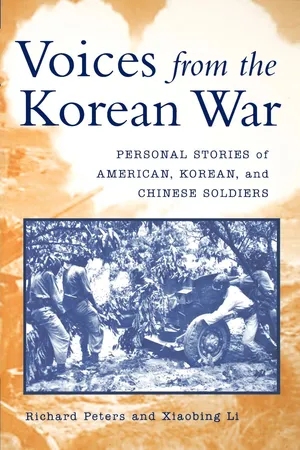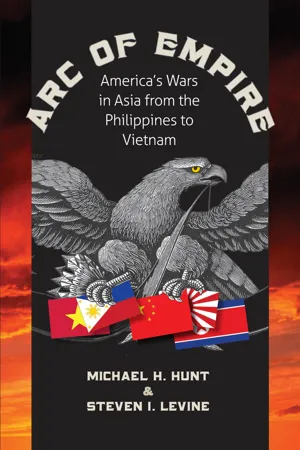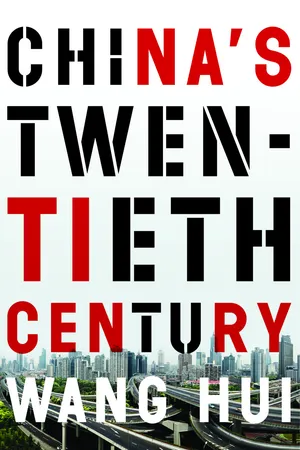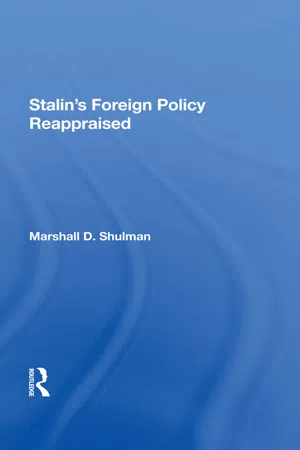History
The Korean war
The Korean War was a conflict between North Korea, supported by China and the Soviet Union, and South Korea, supported by the United Nations and the United States. It began in 1950 when North Korean forces invaded South Korea, and ended in 1953 with an armistice, but no formal peace treaty. The war resulted in the division of Korea into North and South.
Written by Perlego with AI-assistance
Related key terms
7 Key excerpts on "The Korean war"
- eBook - ePub
- Steven Hugh Lee(Author)
- 2013(Publication Date)
- Routledge(Publisher)
Part Three International War in KoreaPassage contains an image
Chapter Three Korea's Global War, 1950–51
DOI: 10.4324/9781315840222-6Political scientist Bruce Cumings (1990 ) has argued that the 1949 border conflict launched the beginning of The Korean war, which itself was the logical culmination of civil conflict within Korea and the consolidation of the two rival regimes. Cumings's thesis is part of a wider historical debate about the relative role of local and international factors in The Korean war. He stresses the peninsular dynamics of The Korean war and argues that Koreans were the prime historical actors shaping the conflict: each hoped to provoke a counter-offensive from the other side so as to enable its own great power backer to enter into the conflict and unify the peninsula. Stalin understood the logic behind this strategy very well [Doc. 9]. In September 1949 the Politburo refused to support Kim Il Sung's plans partly out of fear that a North Korean attack would invite American intervention. Similarly, as we have seen, the United States was unprepared to be drawn into a war initiated by Syngman Rhee.According to Cumings, since the border war began in 1949, the traditional starting date for the war, June 1950, is misleading. However, there is a discontinuity between the 1949 border war and the June 1950 attack which should also be highlighted. The crucial difference was the escalation and internationalization of the war represented by Stalin's decision in early 1950 to back a northern offensive against South Korea. Stalin did not simply ‘order’ the North Koreans to attack, for Kim Il Sung was no simple pawn; rather, Stalin agreed to an initiative put forward by Kim. Further, Stalin's support was qualified, since he would refuse to draw the Soviet Union into the conflict if the United States entered the war. - eBook - ePub
From Lexington to Baghdad and Beyond
War and Politics in the American Experience
- Donald M Snow, Dennis M. Drew(Authors)
- 2015(Publication Date)
- Routledge(Publisher)
6KOREAN WARIf World War II had been the ultimate example of total war, the Korean conflict began the trend back to limited engagement. Begun a mere five years after the conclusion of the Second World War, Korea started a process of adjustment for American military and political leaders. It is a process of understanding and interaction that still continues.The Korean war was a new experience for the United States and for the international order that emerged from the ashes of World War II. For the United States, the experience was unique in at least three ways. First, it was our first limited war in modern (twentieth-century) times. As such, it represented a discontinuity in experience that required painful learning and adjustment. Second, it was the first significant cold war confrontation and represented a novel challenge to the emerging American role in the world. Third, it was the first major American military engagement not preceded by a formal declaration of military intent by the Congress of the United States, and it began a constitutional and political process that culminated in the War Powers Act of 1973. For the international system, Korea was the first instance of the application of the collective security provisions of the United Nations Charter, although not an application as envisaged by its framers. Each of these points is of sufficient importance to merit elaboration.Although the United States had fought wars that were limited in terms of the severity with which they were fought (e.g., the War of 1812) or the ease of their accomplishment (e.g., the Spanish-American War), the Korean conflict was the first time the modern U.S. military, developed and prepared for total war and led by an officer corps steeped in the total wars of the twentieth century, was thrust into a situation in which the political objectives were limited. The result was to create friction between the military and political leaderships. It was a disagreement for which neither group was especially well prepared, and the result was probably unnecessary ill will and inefficiency in the conduct of the hostilities. - eBook - ePub
Voices from the Korean War
Personal Stories of American, Korean, and Chinese Soldiers
- Richard Peters, Xiaobing Li(Authors)
- 2014(Publication Date)
- The University Press of Kentucky(Publisher)
Part One The Korean war A Short HistoryPassage contains an image
Chapter 1
Background and Origins of the WarIt is one of the more unfortunate and ironic events in history that Korea, a nation that prior to 1945 included the most homogeneous and united of all peoples, should become a nation divided. Whatever differences may have existed in regard to caste or class, the Korean people speak the same language throughout the peninsula and, with minor variations between north and south, are of the same culture. This cruel fate is made even more tragic by the fact that the Korean people were divided by other powers—clearly the victims of Cold War politics.1The tragedy of Korea, however, began long before The Korean war. Thanks to victories over China in 1894 and Russia in 1905, between 1905 and 1945 Japan governed Korea as a colony, with the blessings of Great Britain and the United States. The Japanese ruled harshly and backed up their policies with brutal police and army forces as they strived to destroy all vestiges of Korean culture. While Korea did make economic progress under Japanese rule, the political climate remained repressive. In the words of one historian, “Japanese imperialism stuck a knife in old Korea and twisted it, and that wound has gnawed at the Korean national identity ever since.”2The Japanese occupation was made even more difficult for Koreans to accept by their close cultural ties to China and their view of the Japanese as products of inferior culture. Partially for these reasons, in the end the Japanese were unable to extinguish Korean culture and nationalism. When World War II ended in 1945, Korean nationalists, bonded by their common hatred of the Japanese, competed for leadership in the attempt to establish a free and independent Korea.3 - eBook - ePub
Arc of Empire
America's Wars in Asia from the Philippines to Vietnam
- Michael H. Hunt, Steven Levine(Authors)
- 2012(Publication Date)
- The University of North Carolina Press(Publisher)
Several years of intense civil conflict on the Korean peninsula preceded the North Korean invasion of South Korea on 25 June 1950. The ensuing war raged up and down the peninsula for more than three years, quickly drawing in the United States and its allies on the side of South Korea and China on the side of North Korea. Grinding land warfare, savage atrocities committed by both sides, and indiscriminate bombing by the U.S. Air Force inflicted massive death on civilians as well as combatants. Korea’s cities and industries were destroyed and the land itself horribly scarred. Finally, the combatants, unable to enforce their will without risking a wider war, settled for a cease-fire line that ran like a jagged scar across the midsection of the Korean peninsula, not far from the line that had separated rival regimes before the invasion. An inconclusive war doomed the divided country to a future of continued antagonism and tension.In broader terms, The Korean war marked a distinct downward turn in the arc of America’s protracted engagement in eastern Asia. Only a few years earlier that arc had reached its apogee. With Japan subordinated and European empires in postwar retreat, no other power in eastern Asia seemed capable of challenging America’s dominance. But in fact the war in Korea would demonstrate the limits of U.S. power in a region undergoing profound changes. By 1950 nationalist movements in South Asia, Indonesia, the Philippines, Malaya, and Indochina had already gained or were rapidly advancing toward independence. A renascent China, driven by a species of the revolutionary impulse increasingly ascendant in the region, was beginning to reassert its historic interest in its border areas. America’s major Cold War adversary, the Soviet Union, aligned with China in supporting the cause of liberation. Amid these adverse currents, U.S. policymakers would find themselves first drawn onto the Korean battlefield, then constrained there, and finally compelled to accept a frustrating settlement.A REGION IN FERMENT
From the high optimism of the fall of 1945, American leaders had descended rapidly into fear and pessimism. Relations with the World War II Soviet ally soured in late 1945 and early 1946 as the Kremlin fastened its grip on Eastern Europe and probed for advantage in Iran and northeast China. Gradually, President Harry S. Truman resolved to take a stand. His growing hostility toward Moscow was first evident in personal outbursts and comments to close advisers. Then in March 1947 he went public. In a landmark speech to Congress, he asserted the world was deeply divided ideologically and proclaimed a sweeping commitment to support free peoples everywhere threatened by communism. His dramatic affirmation quickly translated into the Marshall Plan to ensure the economic recovery of Western Europe. By 1949, his administration had lined up governments there behind an anti-Soviet position and stitched together the North Atlantic Treaty Organization as a basis for military coordination. - eBook - ePub
China's Twentieth Century
Revolution, Retreat and the Road to Equality
- Wang Hui, Saul Thomas(Authors)
- 2016(Publication Date)
- Verso(Publisher)
The core question regarding war waged outside the borders of one’s own country centers on the nature of the war: Is it rooted in internationalist principles and fought to lend aid to another, or is it rooted in the purely nationalist desire to further the interests of one’s own state? We must be careful not to repudiate all nationalist wars without distinction, however, for we should still consider the political connotations and contexts of these wars: There is a distinction between the nationalism of the oppressed nations and that of the oppressor nations, between imperialist war and war for national liberation, between the nationalism of the old world and the anti-imperialist and anticolonial nationalism of New China and other nations. For China, the wars to aid Korea and to aid Vietnam resisted both imperialism and colonialism and were therefore internationalist. China’s so-called “Self-Defensive Counterattack on Vietnam” in 1979, however, did not have this quality. It is in this sense that this “counterattack” was not part of China’s “short twentieth century,” but rather took place at a time when the curtain had already lowered on the revolutionary century.The First War under a Nuclear Threat: Do People or Material Decide the Outcome of War?
The Korean war was the first large-scale war in human history to occur after the appearance of nuclear weapons. In 1945, after the American nuclear bombing of Hiroshima and Nagasaki, George Orwell was the first person to use the term “cold war.” What did he mean by “cold war”? This was his term for the condition of the world and the relations between states after the appearance of nuclear weapons and the threat of nuclear war. Under the strategic balance of nuclear deterrence, war took the form of the Cold War. In The Korean war, China was engaged in a militarily unbalanced war with an imperialist superpower that was the first to possess nuclear strike capability. Before World War II, no one knew that the United States was developing and might be able to produce nuclear weapons. When China entered The Korean war and started fighting with a dominant country that possessed nuclear weapons, how could it not consider the possibility of a nuclear war? Could this sort of war, extremely unbalanced in terms of armaments, change the possibilities for people’s war?The United States twice made concrete plans to use nuclear weapons during The Korean war. These two plans were linked to the idea of rearming Japan and allowing Taiwan to enter the war. Since 1945, the United States had consistently considered the possibility of using nuclear weapons. After American forces had suffered a severe military debacle in late 1950, MacArthur sent a telegram to Chiang Kai-shek requesting that he send Squadron 52 to Korea, to which Chiang responded promptly and with enthusiasm. Earlier on, MacArthur had drafted a list of targets to be attacked with atomic bombs, which included not only Chinese forces in Korea but also sites in China. On December 30, he suggested to the Department of the Army that the following measures be adopted: 1) Blockade the coast of China; 2) destroy logistical industrial facilities in China; 3) secure the support of GMD troops from Taiwan; and 4) remove existing restrictions on the GMD and possibly allow a counterattack on China.66 Public opinion around the world was shocked when Truman stated in a press conference on November 30 that all necessary measures, including the atomic bomb, would be used to stop the spread of communism in Korea.67 After Eisenhower assumed the presidency in 1953, he revisited Truman’s plans, reopening the nuclear attack plan and urging Chiang Kai-shek to attack mainland China.68 - eBook - ePub
- Marshall D. Shulman, Robert Legvold(Authors)
- 2019(Publication Date)
- Routledge(Publisher)
These measures were not effective, however, while the United Nations was experiencing success in its first test of arms. Each bulletin from the advancing United Nations forces further stimulated the euphoric feeling that Might was at last making Right, that the age-old dream of a world rule of law was being realized on the Korean battlefield. Against this exhilarated drive for total victory in Korea, Jacob Malik’s tentative and ambiguous offers of compromise in the Security Council during August and once again in early September were unavailing. Seeking to head off the crossing of the thirty-eighth parallel by United Nations forces, Vyshinsky made one further diplomatic effort in the General Assembly in early October. Vyshinsky’s resolution held out the promise of an all-Korean election, in return for a cease-fire and a withdrawal of all foreign troops from Korea, with the Chinese Communists participating in a United Nations Commission to observe the elections. The Soviet proposal gained no support outside the Soviet bloc. Instead, the General Assembly passed a resolution which implicitly authorized the unification of Korea by force. This resolution was voted on October 7, just ahead of the news that the forces of the United Nations had swept across the thirty-eighth parallel.The two phases of Soviet policy which followed this development were closely keyed to the rise and fall of Communist fortunes in The Korean war. At first, the massive Chinese intervention in November 1950 produced a serious deterioration in the United Nations military position and within the Western alliance, and a consequent hardening of Soviet policy. Then, after the defeat of the final Chinese Communist offensive in May 1951, the Soviet Union began to turn once again toward conciliation.What role the Soviet Union played in the Chinese intervention in Korea is not clear. In his study of the Chinese entry into the war, Whiting tentatively concludes that Soviet influence was a contributing rather than a determining factor in the Chinese decision.1 From the Soviet point of view, the danger that the United States, intoxicated by its success against the Communist forces in North Korea, might feel encouraged to take the offensive in Asia and elsewhere may have appeared greater because of a number of impassioned statements made at this time by highly placed American military and civilian officials. They urged not only an extension of The Korean war but a more aggressive strategy against the Communist bloc as a whole. Although these statements were disavowed by the President, and some of the officials involved were dismissed from their posts, the Soviet and Chinese leaders may have not known whether to give the statements or the denials greater credence. Another factor in this calculation may have been the air intrusions over Chinese territory attributed to the United States Air Force by the Chinese Communist authorities.2 - eBook - ePub
The Korean War
An International History
- William Stueck(Author)
- 1997(Publication Date)
- Princeton University Press(Publisher)
CHAPTER 10 •The Korean war as International HistoryKOREA AS A SUBSTITUTE FOR WORLD WAR IIIOctober 1950 was a pivotal month in The Korean war. Despite Chinese warnings, UN ground forces crossed the 38th parallel and pushed their way toward the Manchurian border. China responded by sending hundreds of thousands of troops to the peninsula. Unaware of Beijing’s decision, President Truman and General MacArthur met at mid-month on Wake Island in the Pacific Ocean. Brimming with self-confidence, the UN commander assured his commander in chief and a team of advisers that the war was all but won, that U.S. troops could begin to be reassigned from the theater by the end of the year.Secretary of the Army Frank Pace was a member of the Truman team at Wake Island. On his return to Washington, he went to Secretary of Defense Marshall’s Pentagon office to report General MacArthur’s assessment. To Pace’s astonishment, the older man expressed concern. “To precipitate an end to the war,” he opined, “would not permit us to have a full understanding of the problems we face ahead of us.”“But General Marshall,” Pace queried, “do you mean by that the American people would not have fully had the opportunity to grasp the implications of the cold war?”“I certainly do,” Marshall replied. “You didn’t live through the end of World War II the way I did, and watch people rush back to their civilian jobs and leave the tanks to rot in the Pacific and the military strength that was built up to fade away.”“I know, General Marshall,” Pace admitted, “but a great deal of water has passed under the bridge since then.…Would you say I was naive if I said that the American people had learned their lesson?”“No, Pace, I wouldn’t say you were naive,” Marshall answered, “I’d say you were incredibly naive.”1Little did Marshall know that, by the end of the year, U.S. units in Korea would be fighting for their survival in the face of a Chinese onslaught. With the possible exception of a few days in October almost a dozen years later, the cold war was as close to becoming hot on a global scale as at any time in its forty-year history.
Learn about this page
Index pages curate the most relevant extracts from our library of academic textbooks. They’ve been created using an in-house natural language model (NLM), each adding context and meaning to key research topics.

